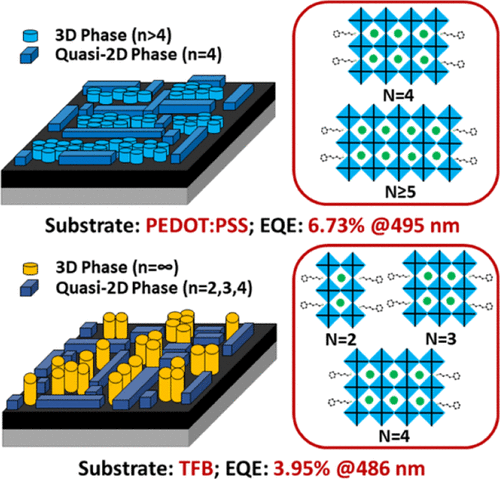当前位置:
X-MOL 学术
›
ACS Appl. Electron. Mater.
›
论文详情
Our official English website, www.x-mol.net, welcomes your
feedback! (Note: you will need to create a separate account there.)
Elucidating the Role of Substrates on Domain Distribution of Quasi-2D Perovskites for Blue Light-Emitting Diodes
ACS Applied Electronic Materials ( IF 4.3 ) Pub Date : 2021-09-07 , DOI: 10.1021/acsaelm.1c00556 Jinqiao Cai 1 , Muhammad Umair Ali 2 , Jinhao Xu 1 , Jingsheng Miao 1 , Jingwei Chen 1 , Ming Liu 1 , Qi Wei 3 , Guichuan Xing 3 , Hong Meng 1
ACS Applied Electronic Materials ( IF 4.3 ) Pub Date : 2021-09-07 , DOI: 10.1021/acsaelm.1c00556 Jinqiao Cai 1 , Muhammad Umair Ali 2 , Jinhao Xu 1 , Jingsheng Miao 1 , Jingwei Chen 1 , Ming Liu 1 , Qi Wei 3 , Guichuan Xing 3 , Hong Meng 1
Affiliation

|
Perovskite light-emitting diodes (PeLEDs) have been developed at a rapid pace with high external quantum efficiencies (EQEs) surpassing 20% for red, infrared, and green emissions; nevertheless, the performance of their blue-emitting cousins remains relatively quite low. Among various crucial factors that could impact these solution-processed devices, selection of a suitable underlayer (usually a hole-transport layer) is critical to the quality of resulting perovskite films. Particularly, the role of the substrate is highly important in the case of quasi-2D perovskite films where the emission occurs as a result of cascade energy transfer among various perovskite domains with different numbers of lead-halide octahedral layers (n) sandwiched between long-chain organic molecules. Herein, we explored the impact of the substrate on domain distribution of quasi-2D perovskite films, and a series of efficient and color-stable blue PeLEDs is attained through precise stoichiometric engineering. By employing a range of characterization tools, we thoroughly investigated the crystallization mechanism of quasi-2D perovskites on different substrates, including poly(3,4-ethylenedioxythiophene):poly(styrenesulfonate) (PEDOT:PSS) and poly[(9,9-dioctylfluorenyl-2,7-diyl)- co -(4,4′-( N -(4-sec-butylphenyl)diphenylamine)] (TFB). Perovskite films spin-coated on PEDOT:PSS exhibited cyan emission from the n ≥ 4 quasi-2D phase with uniformly distributed small grains. In contrast, perovskite layers formed on TFB featured an island morphology and showed blue emission from the quasi-2D phase with n-values between 2 and 4. In addition, we examined how the variation of A-site cations affects the optical properties of quasi-2D perovskites. Consequently, PEDOT:PSS-based champion PeLED exhibited cyan emission at 495 nm with a maximum EQE of 6.73%, whereas TFB-based counterparts manifested blue emission at 486 nm with a peak EQE of 3.95%. We anticipate that our work will provide a fundamental guideline to rationally selecting the substrates for the optimized growth of quasi-2D perovskites toward high-efficiency PeLEDs.
中文翻译:

阐明衬底对蓝光发光二极管准二维钙钛矿畴分布的作用
钙钛矿发光二极管 (PeLED) 发展迅速,具有高外量子效率 (EQE),红光、红外光和绿光发射超过 20%;尽管如此,它们发出蓝光的表亲的性能仍然相对较低。在可能影响这些溶液处理设备的各种关键因素中,选择合适的底层(通常是空穴传输层)对于所得钙钛矿薄膜的质量至关重要。特别是,在准二维钙钛矿薄膜的情况下,基板的作用非常重要,其中发射是由于具有不同数量的卤化铅八面体层(n) 夹在长链有机分子之间。在此,我们探索了基板对准二维钙钛矿薄膜畴分布的影响,并通过精确的化学计量工程获得了一系列高效且颜色稳定的蓝色 PeLED。通过使用一系列表征工具,我们彻底研究了准二维钙钛矿在不同基材上的结晶机制,包括聚(3,4-乙撑二氧噻吩):聚(苯乙烯磺酸盐)(PEDOT:PSS)和聚[(9,9-二辛基芴基-2,7-二基)- co -(4,4'-( N -(4-sec-butylphenyl)diphenylamine)] (TFB). 旋涂在 PEDOT:PSS 上的钙钛矿薄膜表现出来自n 的青色发射≥ 4 个具有均匀分布的小晶粒的准二维相。相比之下,在 TFB 上形成的钙钛矿层具有岛状形态,并从准 2D 相显示蓝色发射,n 值在 2 和 4 之间。此外,我们研究了 A 位阳离子的变化如何影响准二维相的光学性质。 -2D 钙钛矿。因此,基于 PEDOT:PSS 的冠军 PeLED 在 495 nm 处表现出青色发射,最大 EQE 为 6.73%,而基于 TFB 的对应物在 486 nm 处表现出蓝色发射,峰值 EQE 为 3.95%。我们预计我们的工作将为合理选择基板以优化准二维钙钛矿向高效 PeLED 生长提供基本指导。
更新日期:2021-09-28
中文翻译:

阐明衬底对蓝光发光二极管准二维钙钛矿畴分布的作用
钙钛矿发光二极管 (PeLED) 发展迅速,具有高外量子效率 (EQE),红光、红外光和绿光发射超过 20%;尽管如此,它们发出蓝光的表亲的性能仍然相对较低。在可能影响这些溶液处理设备的各种关键因素中,选择合适的底层(通常是空穴传输层)对于所得钙钛矿薄膜的质量至关重要。特别是,在准二维钙钛矿薄膜的情况下,基板的作用非常重要,其中发射是由于具有不同数量的卤化铅八面体层(n) 夹在长链有机分子之间。在此,我们探索了基板对准二维钙钛矿薄膜畴分布的影响,并通过精确的化学计量工程获得了一系列高效且颜色稳定的蓝色 PeLED。通过使用一系列表征工具,我们彻底研究了准二维钙钛矿在不同基材上的结晶机制,包括聚(3,4-乙撑二氧噻吩):聚(苯乙烯磺酸盐)(PEDOT:PSS)和聚[(9,9-二辛基芴基-2,7-二基)- co -(4,4'-( N -(4-sec-butylphenyl)diphenylamine)] (TFB). 旋涂在 PEDOT:PSS 上的钙钛矿薄膜表现出来自n 的青色发射≥ 4 个具有均匀分布的小晶粒的准二维相。相比之下,在 TFB 上形成的钙钛矿层具有岛状形态,并从准 2D 相显示蓝色发射,n 值在 2 和 4 之间。此外,我们研究了 A 位阳离子的变化如何影响准二维相的光学性质。 -2D 钙钛矿。因此,基于 PEDOT:PSS 的冠军 PeLED 在 495 nm 处表现出青色发射,最大 EQE 为 6.73%,而基于 TFB 的对应物在 486 nm 处表现出蓝色发射,峰值 EQE 为 3.95%。我们预计我们的工作将为合理选择基板以优化准二维钙钛矿向高效 PeLED 生长提供基本指导。











































 京公网安备 11010802027423号
京公网安备 11010802027423号